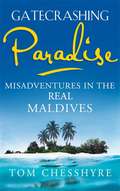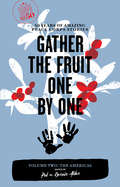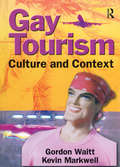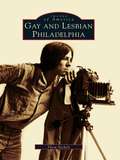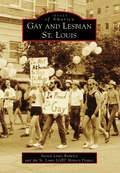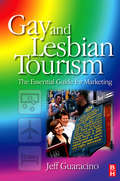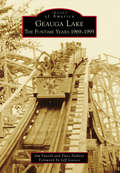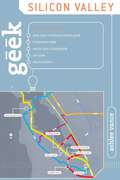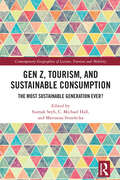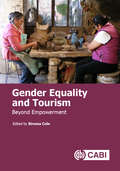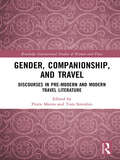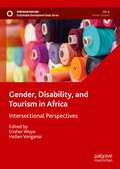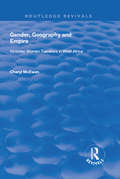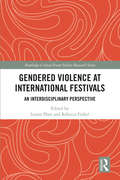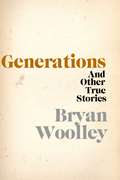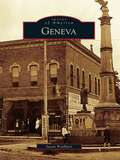- Table View
- List View
Gatecrashing Paradise: Misadventure in the Real Maldives
by Tom ChesshyreAway from the five-star hotels and beyond luxury hideaways, Tom Chesshyre travels to see the real, unexplored Maldives, skirting around the archipelago's periphery, staying at simple guesthouses, and using cargo ships and ferries. He discovers that beyond the glossy brochures lies an almost undiscovered country that is brimming with life, yet also a paradise teetering on the brink of trouble.In the Maldives outsiders used to be banned from islands not officially endorsed as tourist resorts, but now a thousand sandy shores can be visited in this remote nation deep in the Indian Ocean the flattest on Earth.This is island-hopping for the twenty-first century, sailing around 600 miles of the most beautiful islands and atolls on Earth, often to communities that have not seen an outsider for decades, ...and gatecrashing the odd posh hotel.
Gateway to Yellowstone: The Raucous Town of Cinnabar on the Montana Frontier
by Lee Whittlesey Lee H. WhittleseyBy 1883 when the rail lines of the Northern Pacific reached the tiny town of Cinnabar, Montana Territory, newspaper and magazine stories of the wonders to be found in Yellowstone National Park had been firing the imaginations of eager potential visitors around the world for a decade. Once the railroad completed that critical bit of their route, the world was poised to actually see the magic of Yellowstone, and the prospect of a trip was no longer just exciting—it was a possibility. It seemed like everyone who could afford the ticket—from middle class residents of New York City to Army Generals William Tecumseh Sherman and Philip Sheridan to President Chester A. Arthur—wanted to ride the train to see Yellowstone . Their jumping off point for their journey into &“Wonderland&” was the town envisioned by Hugo Hoppe, a raucous Wild West town poised for greatness as the Gateway to all of Yellowstone&’s offerings. The town of Cinnabar, Montana, no longer exists, but when it did, it served as the immediate railroad gateway for a generation of visitors to Yellowstone National Park. Visitors passed through its streets from September 1, 1883, through June 15, 1903 This book tells the story of its place in the West, and the legend of the town and its promoters. Its story is one of aspiration and dreams in the American West and its place in the legend and lore of Yellowstone has kept the spirit of Cinnabar alive for more than a hundred years since the town itself faded away.
Gather the Fruit One by One: 50 Years of Amazing Peace Corps Stories
by Bernie Alter Pat AlterTake some Inca, Aztec, Maya, and Moche, mix in Spanish, French, English, Dutch and Danish, stir it to the rhythmic beat of Africa and what do you get? A zesty brew, expressed in a callaloo soup of language, food, music, and religion. So much passion, so much sorrow. What seems familiar in the Americas often is not. For Peace Corps Volunteers, there is nothing to do but learn the language, roll up their sleeves, and get busy working alongside strangers who steal their hearts away. These stories take you on overland journeys to the Amazon Basin, into a village in Honduras terrorized by insurgent forces, and to the ball fields of Ecuador for an unusual game of "beisbol."
Gators and Seminoles: A Football Rivalry for the Ages (Images of Sports)
by Kevin M. MccarthyThe University of Florida and Florida State University are two of the best institutions of higher learning in the third most populous state in our country. They cooperate in many academic ventures and have joint programs, especially in the sciences. They do not, however, cooperate in athletic endeavors and, in fact, compete fiercely in all sports, especially football. Since 1958, when they first started playing football against each other, they have met 60 times, twice in postseason bowl games, one of which was for the national championship. The two teams have each had three Heisman Trophy winners and have won the national championship in Division I a total of 13 times: five for Florida and eight for Florida State. This then is the story of one of this country's fiercest football rivalries, complete with outstanding players and coaches, as well as controversies.
Gay Tourism: Culture and Context
by Gordon Waitt Kevin MarkwellThe gay tourism industry-a progressive social force or a pull towards an oppressive status quo?The pink tourism dollar is now recognized as a highly profitable niche of the tourism market. Gay Tourism: Culture and Context critically investigates the emergence of a commercial gay tourism industry for male clients, the way it is organized, and how the tourism industry promotes cities, resorts, and nations as &’gay&’ destinations. This careful examination critically questions the social, political, and cultural implications regarding relationships between gay tourism, Western gay male culture, the erotic, sexual politics, and sexual diversity.Gay Tourism: Culture and Context begins by detailing how travel often enabled the expression of Western same-sex male desire in the nineteenth century and then charts the emergence of a Western gay tourism industry in the late twentieth century. A critical analysis is given of gay guidebooks and erotic videos that help to establish and maintain destinations as seemingly gay utopias, including Hawaii and the Greek island Mykonos. Carefull consideration as to debates about how the gay tourism industry operates in the context of questions regarding the globalization of sexuality, sexual citizenship and place-marketing of (homo)sexualised cities. The text includes an extensive bibliography plus several photographs, charts, and figures to clearly present concepts and ideas.Topics in Gay Tourism: Culture and Context include: the history of gay travel and tourism the effect of HIV/AIDS on gay tourist destinations gay travel writing sustaining same-sex fantasies about popular gay tourist destinations analysis of the socio-political ramifications of gay tourism the sexual politics of a heterosexual nation gay tourists as an "invading force" of corruption the economic rationale for the (homo)sexualized city the concept of "gay villages" the role of special events and festivals in gay tourism and many more!Gay Tourism: Culture and Context is enlightening reading for tourism policymakers, tourism planners, tourism managers, and teachers and students in the fields of tourism studies, gay studies, social and cultural geography, and sociology.
Gay and Lesbian Philadelphia (Images of America)
by Thom NickelsThe diverse landscape of gay and lesbian Philadelphia is a story of highs and lows. From rustic post-Civil War days when Camden poet Walt Whitman crossed the Delaware River on a ferry or caroused Market Street "eyeing" the grocery boys, to the beginnings of ACT UP more than one hundred years later, the gay and lesbian community in Philadelphia has never lost its flair for the dramatic.Gay and Lesbian Philadelphia is a historical look at the neighborhoods, events, and people that have been a part of this community. The 1920s saw the birth of private dance bars on Rittenhouse Square. It was a time when drag shows in straight bars were the order of the day, as was the presence of men in drag during the annual Mummer's Parade on New Year's Day. The pre-Civil Rights era, when segregation was the status quo, saw the proliferation of African American house parties in neighborhoods such as North Philadelphia, where black gays and lesbians formed a community. During the 1950s and 1960s, Rittenhouse Square was the site of informal public gatherings. These gatherings of friends and strangers helped set the stage for the Annual Reminder, the first public protest in support of "homosexual equal rights," which took place every Fourth of July at Independence Hall. Throughout all of these eras, members of the community faced challenges, celebrated victories, and continued to try to blend their lives with those of their gay and straight neighbors.
Gay and Lesbian St. Louis (Images of America)
by St. Louis LGBT History Project Steven Louis BrawleyIn the late 19th century, St. Louis--America's fourth-largest city--was a hub of robust commerce and risqué entertainment. It provided an oasis for those who lived "in the shadows." Since 1764, the Gateway to the West's LGBT community has experienced countless struggles and successes, including protests, arrests, murders, celebrations, and parades. St. Louis had its own version of Stonewall in October 1969 and is the hometown of icons such as Tennessee Williams and Josephine Baker. A colorful array of activists, drag queens, leather men, artists, academics, business leaders, and everyday folks have contributed to the rich fabric of the lesbian and gay community in St. Louis.
Gay and Lesbian Tourism
by Jeff GuaracinoThis unique introductory resource provides a broad foundation of knowledge on the gay and lesbian market segment. Topics and themes are illustrated by interviewing the top professionals in gay travel and gay media who share their experience, tips for success and future predictions. Packed with best case examples and practices of existing gay tourism initiatives and campaigns, this engaging text provides analysis and context that addresses some of the burning questions in this area, including the potential negative consumer and stakeholder reaction, and strategies to educate the local hospitality community.
Gaysia: Adventures in the Queer East
by Benjamin LawBenjamin Law considers himself pretty lucky to live in Australia: he can hold his boyfriend's hand in public and lobby his politicians to recognize same-sex marriage. But as the child of immigrants, he's also curious about how different life might have been had he grown up in Asia. So he sets off to meet his fellow Gaysians. Law takes his investigative duties seriously, going nude where required in Balinese sex resorts, sitting backstage for hours with Thai ladyboy beauty contestants, and trying Indian yoga classes designed to cure his homosexuality. The characters he meets — from Tokyo's celebrity drag queens to HIV-positive Burmese sex workers and Malaysian ex-gay Christian fundamentalists to Chinese gays and lesbians who marry each other to please their parents — all teach him something new about being queer in Asia. At once entertaining and moving, Gaysia is a wild ride and a fascinating quest by a leading Australian writer.
Geauga Lake: The Funtime Years 1969-1995
by Jim Futrell Dave Hahner Jeff LococoIn 1968, three businessmen left their jobs at Cedar Point in Sandusky to purchase Geauga Lake Amusement Park. Geauga Lake had been a summertime escape since the 1870s, but by the 1960s it had fallen on hard times. The businessmen's company, Funtime, Inc., transformed the aging facility into a modern amusement park and established a reputation as an innovative operator in one of the nation's most competitive amusement park markets. Geauga Lake became the first park with two looping roller coasters and the first to integrate a full-scale water park, Boardwalk Shores. The company broke even more new ground in 1988 when it resurrected a classic roller coaster design to construct Raging Wolf Bobs. Images of America: Geauga Lake: The Funtime Years 1969-1995 captures the park's transformation and some of the countless memories that resulted from Funtime's 26-year ownership.
Geek Silicon Valley: The Inside Guide to Palo Alto, Stanford, Menlo Park, Mountain View, Santa Clara, Sunnyvale, San Jose and San Francisco
by Ashlee VanceSilicon Valley veterans and newbies alike will want to explore this book that delves into the rich history behind the region that birthed the world's most important industry. Technology journalist Ashlee Vance has captured almost every aspect of the area stretching between San Francisco and San Jose, California, starting with the eager radio and electronics enthusiasts of the early 1900s and ending with the computing powerhouses of today such as Google and Apple. Along the way, the book profiles the people and places that have elevated Silicon Valley to an almost mythic pedestal. This book delivers Silicon Valley, taking us from success story to failed startup and back again as we drive the roads from San Francisco to Menlo Park, Palo Alto, Mountain View, Sunnyvale, Santa Clara and San Jose. It's full of profiles of the larger-than-life characters that pioneered the processor, computer, and Internet revolutions. The book's vibrant design includes "Silicon Valley Soundbytes" packed with insider information and trivia, and "Click Here" sidebars, which suggest places to eat, drink, and shop.
Geek Silicon Valley: The Inside Guide to Palo Alto, Stanford, Menlo Park, Mountain View, Santa Clara, Sunnyvale, San Jose, San Francisco
by Ashlee VanceSilicon Valley veterans and newbies alike will want to explore this book that delves into the rich history behind the region that birthed the world's most important industry. Technology journalist Ashlee Vance has captured almost every aspect of the area stretching between San Francisco and San Jose, California, starting with the eager radio and electronics enthusiasts of the early 1900s and ending with the computing powerhouses of today such as Google and Apple. Along the way, the book profiles the people and places that have elevated Silicon Valley to an almost mythic pedestal. This book delivers Silicon Valley, taking us from success story to failed startup and back again as we drive the roads from San Francisco to Menlo Park, Palo Alto, Mountain View, Sunnyvale, Santa Clara and San Jose. It's full of profiles of the larger-than-life characters that pioneered the processor, computer, and Internet revolutions. The book's vibrant design includes "Silicon Valley Soundbytes" packed with insider information and trivia, and "Click Here" sidebars, which suggest places to eat, drink, and shop.Place by place, readers get the inside scoop on all the addresses that count, which include Microsoft research centers; the headquarters of Google, Hewlett-Packard, Intel, Sun Microsystems, and Oracle; research powerhouses such as Stanford University, NASA Ames, and Lawrence Livermore National Laboratory; the Computer History Museum and The Tech Museum; the Shoreline Amphitheater; the Churchill Club; and many more.
Gelato: Finding Italy's Best Gelaterias (Happy Belly Guides)
by Michael McGarryGelato contains reviews of over fifty of the best gelaterias in Italy's most visited cities. Additional Gelato Lore sections explore the history and myths surrounding this long-revered treat and Tips & Info sections assist readers on a variety of gelato-related matters, including how to spot a worthwhile gelateria and an explanation of the differences between gelato and ice cream. With 4-color photographs and illustrations throughout, this book is truly gelato for the eyes. Whether recommending the sublime riso (rice) gelato at Florence's beloved Vivoli or the breathtaking view of Capri from Naples' Bilancioni, each entry presents up-to-date information for travelers looking to optimize their gelato consumption, while enjoying an authentic Italian custom. Stories range from Nero's quest for snow from remote mountains to how a Tuscan chicken farmer helped introduce gelato to France.
Gen Z, Tourism, and Sustainable Consumption: The Most Sustainable Generation Ever? (Contemporary Geographies of Leisure, Tourism and Mobility)
by C. Michael Hall Siamak Seyfi Marianna StrzeleckaGen Z, Tourism, and Sustainable Consumption is the first book to provide a comprehensive account of Generation Z in relation to sustainable consumption practices and travel cultures. Gen Z is regarded as the world’s largest consumer market. The growth and behaviour of this economically significant market will have enormous implications for the future development of the tourism industry and destinations and its long-term sustainability. Characterised as being the first generation to grow up with the Internet and sometimes even referred to as the i-Generation, Gen Z is broadly regarded as having an avid interest in travel but seeks to do so in a way that is socially and environmentally conscious, mobile connected, and grounded in authentic local experiences. Logically structured and featuring contributions from a plethora of experts on the topic, this volume provides a critical examination of Gen Z consumer and travel behaviour in a comparative international context and its implications for the tourism, hospitality, and events industries. Embellished with illustrative figures and tables throughout, this book will be of pivotal interest not only to policy makers, destination management and marketing organisations (DMOs), and students of tourism, hospitality, sustainable consumption, and consumer culture, but also to those who seek to cater to this key market.
Gender Equality and Tourism: Beyond Empowerment
by Stroma Cole Carlos Costa Kylie Radel Lucy Ferguson Daniela Moreno Alarcón Marília Durão Zélia Breda Fiona Eva Bakas Paola Vizcaino Suárez Belén Martínez Caparrós Meghan Muldoon Wendy Wendy Heather Jeffrey Isis Arlene Díaz-Carrión Hazel Tucker Inês CarvalhoDoes tourism empower women working in and producing tourism? How are women using the transformations tourism brings to their advantage? How do women, despite prejudice and stereotypes, break free, resist and renegotiate gender norms at the personal and societal levels? When does tourism increase women's autonomy, agency and authority? The first of its kind this book delivers: A critical approach to gender and tourism development from different stakeholder perspectives, from INGOs, national governments, and managers as well as workers in a variety of fields producing tourism. Stories of individual women working across the world in many aspects of tourism. A foreword by Margaret Bryne Swain and contributions from academics and practitions from across the globe. A lively and accessible style of writing that links academic debates with lived realities while offering hope and practical suggestions for improving gender equality in tourism. Gender Equality and Tourism: Beyond Empowerment, a critical gendered analysis that questions the extent to which tourism brings women empowerment, is an engaging and thought-provoking read for students, researchers and practitioners in the areas of tourism, gender studies, development and anthropology. To access a presentation delivered by Stroma Cole as well as an interview with her, please visit http://www.cabi.org/openresources/94422
Gender Equality and Tourism: Beyond Empowerment
by Carlos Costa Kylie Radel Lucy Ferguson Daniela Moreno Alarcón Marília Durão Zélia Breda Fiona Eva Bakas Belén Martínez Caparrós Meghan Muldoon Wendy Wendy Heather Jeffrey Isis Arlene Díaz-Carrión Hazel Tucker Inês Carvalho Paola Vizcaino-SuárezDoes tourism empower women working in and producing tourism? How are women using the transformations tourism brings to their advantage? How do women, despite prejudice and stereotypes, break free, resist and renegotiate gender norms at the personal and societal levels? When does tourism increase women's autonomy, agency and authority? The first of its kind this book delivers: A critical approach to gender and tourism development from different stakeholder perspectives, from INGOs, national governments, and managers as well as workers in a variety of fields producing tourism. Stories of individual women working across the world in many aspects of tourism. A foreword by Margaret Bryne Swain and contributions from academics and practitions from across the globe. A lively and accessible style of writing that links academic debates with lived realities while offering hope and practical suggestions for improving gender equality in tourism. Gender Equality and Tourism: Beyond Empowerment, a critical gendered analysis that questions the extent to which tourism brings women empowerment, is an engaging and thought-provoking read for students, researchers and practitioners in the areas of tourism, gender studies, development and anthropology. To access a presentation delivered by Stroma Cole as well as an interview with her, please visit http://www.cabi.org/openresources/94422
Gender, Companionship, and Travel: Discourses in Pre-modern and Modern Travel Literature (Routledge International Studies of Women and Place)
by Floris Meens Tom SintobinOver the last couple of decades there has been a strong academic interest in how individuals interact with each other while en route. Yet, even if various studies have informed us about present-day realities of travel companionships, we know little about the influence of gender both on these realities, as well as on the discourse in which these are being narrated. This book aims to establish an agenda for the study of companionship in travel writing by offering a collection of new essays which study texts that belong to the broad category of pre-modern and modern travel literature. Chapters explore the differences and similarities in the ways that women and men in the past chose to describe their experiences with, and/or their ideas about companionship, and specifically reveals the influence of gender norms, conventions, restrictions, and stereotypes. This is the first book which looks at the long-term, interdisciplinary, and genuinely international history of gendered discourses on companionship in travel writing. It will be of interest to scholars and students from a wide variety of disciplines, including cultural and social history, as well as cultural, literary, gender, travel, and tourism studies.
Gender, Disability, and Tourism in Africa: Intersectional Perspectives (Sustainable Development Goals Series)
by Erisher Woyo Hellen VenganaiThis book explores the intersection of gender and disability in the context of tourism. In part, the book foregrounds feminist theorising of intersectionality by examining how gender can overlap with other social identities to contribute to more systemic oppression, domination, discrimination, and marginalisation of certain categories of people. Our point of departure is that disability does not operate in isolation as it is constituted and experienced within an already gendered social and tourism environment. With substantial research on the intersection of gender and tourism on the one hand, and the intersection of disability and tourism on the other hand, the interconnectedness of gender and disability and the implications this has on tourism policy and practice remains understudied. Thus, the book provides a critical lens that helps unpack underlying assumptions about gender and disability while questioning the dominant ideas about gender and disability reproduced through tourism policies and institutional practices in an African context. This book will be of interest to scholars and researchers in Gender Studies, Disability Studies, and Tourism Studies, particularly those with a research interest in Africa.
Gender, Geography and Empire: Victorian Women Travellers in Africa
by Cheryl McEwanThis title was first published 2000: This text is intended to draw together two important developments in contemporary geography: firstly, the recognition of the need to write critical histories of geographical thought and, particularly, the relationship between modern geography and European imperialism; and secondly, the attempt by feminist geographers to countervail the absence of women in the histories. The author focuses on the narratives of British women travellers in West Africa between 1840 and 1915, exploring their contributions to British imperial culture, teh ways in which they wer empowered in the imperial context by virtue of both "race" and class, and their various representations of West African landscapes and peoples. The book argues for the inclusion of women and their experiences in histories of geographical thought and explores the possibilities and problems of combining feminist and post-colonial approaches to these histories.
Gender, Tourism Entrepreneurship and Social Policy (Current Developments in the Geographies of Leisure and Tourism)
by Albert Nsom Kimbu Anna De Jong Michael Zisuh NgoasongThis timely volume is a novel and important contribution to scholarly literature on gender and tourism entrepreneurship, utilising feminist and post‑colonial frameworks to interrogate the role of social policies in facilitating inclusive tourism entrepreneurship.Drawing on contributions and case studies from across the Global South and Global North, this multi‑disciplinary collection identifies how regional variations in governance and policy influence the experiences and potentialities of tourism entrepreneurship as a promised avenue for inclusive growth for marginalised identities. Problematizing universalised constructions of entrepreneurs as necessarily masculine, western, and driven only by economic imperatives that seek to fix and dislocate entrepreneurial support, this volume takes focus with place‑based approaches to explore the intersections between identity, tourism entrepreneurship and social policy. It is this geographically informed perspective that seeks to account for the complexity of entrepreneurial experience, and the role of social policy within this, that constitutes an original contribution to the field. The focus on gender and social policy reflects the increasing importance of tourism entrepreneurship within the context of the UNWTOs Sustainable Development Goals.This book will be a pivotal resource for students, researchers, academics and policy makers in tourism, gender studies, development studies, sustainability and business.
Gendered Violence at International Festivals: An Interdisciplinary Perspective (Routledge Critical Event Studies Research Series.)
by Rebecca Finkel Louise PlattGendered Violence at International Festivals is a groundbreaking collection that focusses on this highly important social issue for the first time. Including a diverse range of interdisciplinary studies on the issue, the book contests the widely held notion that festivals are temporal spaces free from structural sexism, inequalities or gender power dynamics. Rather, they are spaces where these concerns are enhanced and enacted more freely and where the experiential environment is used as an excuse or as an opportunity to victim blame and shame. In this emerging and under-researched area, the chapters not only present original work in terms of topics but also in theoretical and methodological approaches. All of the chapters are cross- or interdisciplinary, drawing on gender, sexualities, cultural and ethnicity studies. Studies from a range of highly regarded academics based around the world examine the subject by looking at examples from a wide range of destinations, including Spain, Argentina, Nigeria, Zimbabwe, Australia, Canada and the UK. This significant book progresses understanding and debates about gendered festival experiences and emphasises the symbolic and physical violence often associated with them. This will be of great interest to, undergraduate and postgraduate students and academics in the field of Events Studies. It will also be of use to practitioners or non-profit workers in the festival industries, including festival management organisations and planning committees.
Generation Z Marketing and Management in Tourism and Hospitality: The Future of the Industry
by Sarah Williams Roya Rahimi Nikolaos Stylos Bendegul OkumusGeneration Z (Gen Z) is the demographic cohort also known as Post-Millennials, the iGeneration or the Homeland Generation. Referring to individuals born roughly between the mid-1990s and the early 2000s, they are our youngest consumers, students, colleagues, and voters. Understanding them is a key aspect. In the context of the hospitality and tourism, Gen Z-ers represent the future in human resources, and service production and consumption. This book focuses on the aspirations, expectations, preferences and behaviours related to individuals within this demographic. It critically discusses their dynamism in driving the tourism sector and offers insights into the roles that Gen Z will inhabit as visitors, guests, consumers, employees, and entrepreneurs. This book is a valuable resource for managers, scholars and students interested in acquiring concrete knowledge on how Gen Z will shape the marketing and management of tourism-related services.
Generations and Other True Stories
by Bryan WoolleyIn this volume of twenty-five pieces, Bryan Woolley explores Dashiell Hammett' San Francisco, recalls the lost golden age of Mineral Well, Texas; returns to the site of a mysterious 1947 crash, believed to be a UFO, in Roswell, New Mexico; and attends a "bulldogging" school in Madisonville, Texas. He meets such people as Kinky Friedman, musician and mystery writer; talks to the residents of Alpine, Texas, about their famous newcomer, Robert James Waller, author of Bridges of Madison County, and mourns the retirement of cartoonist Gary Larson.
Generations of Somerset Place: From Slavery to Freedom (Images of America)
by Dorothy Spruill RedfordWhen the institution of slavery ended in 1865, Somerset Place was the third largest plantation in North Carolina. Located in the rural northeastern part of the state, Somerset was cumulatively home to more than 800 enslaved blacks and four generations of a planter family. During the 80 years that Somerset was an active plantation, hundreds of acres were farmed for rice, corn, oats, wheat, peas, beans, and flax. Today, Somerset Place is preserved as a state historic site offering a realistic view of what it was like for the slaves and freemen who once lived and worked on the plantation, once one of the Upper South's most prosperous enterprises.
Geneva (Images of America)
by Susan BradburnThe area's first settlers, Theobalt Bartholomew and his family, left Charlotte, New York, and arrived on South Ridge Road near Cowles Creek in 1805. Geneva, however, was named by another early settler, Maj. Levi Gaylord, who suggested naming it after the small, beautiful town of Geneva, New York. By the mid-1800s, word traveled back to the East Coast of the fertile soil in Ohio, and soon many farmers came on horseback, in oxcarts, and on foot, driving herds of cattle to the area, and the population grew to about 150. The area along Lake Erie soon became a popular tourist destination with its grape-growing industry, Ohio's first resort, and fishing in the Grand River. The area prospered into a community united by work, recreation, and sport. This collection of historic images highlights the histories of Geneva, Geneva on the Lake, and Harpersfields from 1805 to the present day.
